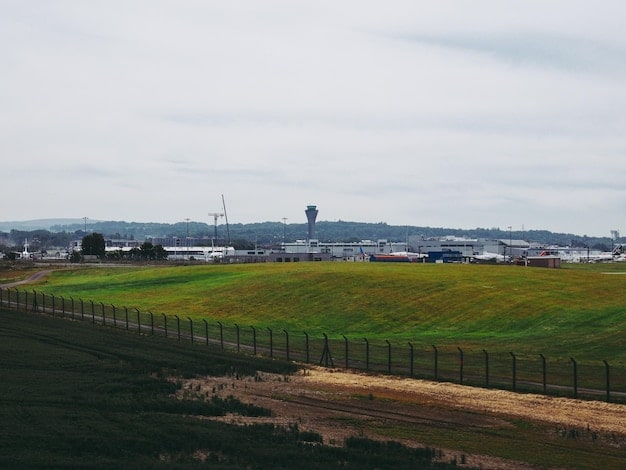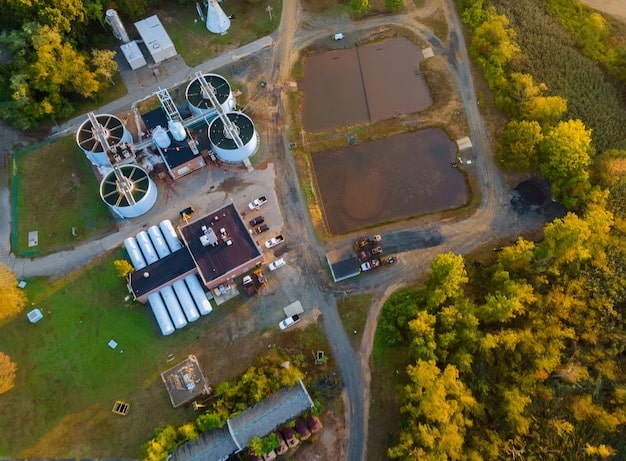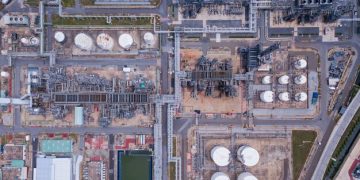Anaerobic Digestion: A Guide for US Farmers on Renewable Energy & Waste Management

Anaerobic digestion offers US farmers a powerful solution for renewable energy production and efficient waste management by converting organic materials into biogas and valuable soil amendments, fostering sustainable agricultural practices.
Discover how anaerobic digestion can revolutionize US farms, turning waste into valuable renewable energy and promoting sustainable agricultural practices. Learn how this innovative technology can benefit your farm.
Harnessing Anaerobic Digestion: A New Era for US Farms
Anaerobic digestion is emerging as a game-changer for US farmers, offering a pathway to both generate renewable energy and manage agricultural waste effectively. This process not only addresses environmental concerns but also provides farmers with new revenue streams and cost savings.
What is Anaerobic Digestion?
Anaerobic digestion is a natural process where microorganisms break down organic matter in the absence of oxygen. This breakdown produces biogas, a mixture primarily of methane and carbon dioxide, which can be used as a renewable energy source.
The remaining solid and liquid material, known as digestate, is a nutrient-rich substance that can be used as fertilizer, reducing the need for synthetic fertilizers.
The Benefits for US Farmers
For US farmers, the adoption of anaerobic digestion can lead to significant benefits, including reduced waste, lower energy costs, and new income streams. It also promotes sustainable farming practices that can improve soil health and reduce environmental impact.
- Renewable Energy Production
- Efficient Waste Management
- Reduced Fertilizer Costs
- Improved Soil Health
By embracing anaerobic digestion, US farmers can enhance their operational efficiency while contributing to a more sustainable future.

In conclusion, anaerobic digestion represents a viable and sustainable solution for US farms, simultaneously addressing waste management challenges and offering renewable energy alternatives.
Understanding the Anaerobic Digestion Process
To fully appreciate the potential of anaerobic digestion, it’s essential to understand the process involved. From feedstock preparation to biogas utilization, each step plays a crucial role in maximizing efficiency and environmental benefits.
Feedstock Collection and Preparation
The anaerobic digestion process begins with the collection and preparation of organic materials, known as feedstock. This feedstock can include a variety of agricultural wastes, such as manure, crop residues, and food processing byproducts.
Proper preparation of the feedstock ensures optimal digestion by increasing the surface area for microbial action and balancing the carbon-to-nitrogen ratio.
The Digestion Process: Stages and Conditions
Anaerobic digestion occurs in four main stages: hydrolysis, acidogenesis, acetogenesis, and methanogenesis. Each stage is facilitated by different groups of microorganisms that work together to break down the organic matter.
- Hydrolysis: Breakdown of complex organic molecules into simpler compounds.
- Acidogenesis: Conversion of these compounds into volatile fatty acids.
- Acetogenesis: Conversion of fatty acids into acetic acid, hydrogen, and carbon dioxide.
- Methanogenesis: Production of methane from acetic acid, hydrogen, and carbon dioxide.
Maintaining the right temperature, pH, and nutrient levels is crucial for optimal microbial activity and biogas production. This often involves continuous monitoring and adjustments to the digester environment.
By understanding and optimizing each stage of the anaerobic digestion process, farmers can maximize biogas production and improve the overall efficiency of their operations.
Types of Anaerobic Digesters Suitable for US Farms
Selecting the right type of anaerobic digester is crucial for US farmers looking to implement this technology. Different digester designs vary in cost, complexity, and suitability for different types of feedstock and farm sizes.
Covered Lagoon Digesters
Covered lagoon digesters are typically the simplest and least expensive option. They consist of a large, earthen lagoon covered with an airtight membrane to capture biogas.
These digesters are best suited for farms with large quantities of liquid manure and warm climates. However, they may have lower biogas production rates compared to other types.

Complete Mix Digesters
Complete mix digesters involve a heated tank with a mixing system to maintain a uniform mixture of feedstock and microorganisms. This design allows for better control of the digestion process and higher biogas production rates.
These digesters are suitable for a wide range of feedstocks and climates but require more intensive management and higher upfront investment.
Plug Flow Digesters
Plug flow digesters are long, rectangular tanks where the feedstock is fed in at one end and slowly moves through the digester as it is digested. These systems are well-suited for handling fibrous feedstocks like crop residues.
However, plug flow digesters can be more challenging to manage and may require more maintenance compared to other types.
Choosing the right digester type depends on the specific needs and resources of the farm, including the type and amount of feedstock available, the climate, and the desired level of management and investment.
The Role of Anaerobic Digestion in Waste Management
One of the key advantages of anaerobic digestion is its ability to efficiently manage agricultural waste. By diverting organic waste from landfills, this technology can significantly reduce greenhouse gas emissions and environmental pollution.
Reducing Methane Emissions
Methane is a potent greenhouse gas that is released when organic waste decomposes in landfills. Anaerobic digestion captures this methane and converts it into biogas, which can be used as a renewable energy source.
This process not only prevents methane from entering the atmosphere but also reduces the need for fossil fuels, further mitigating greenhouse gas emissions.
Managing Manure and Crop Residues
Anaerobic digestion is particularly effective for managing manure and crop residues, which can be significant sources of pollution on farms. By processing these materials in a digester, farmers can reduce odors, pathogens, and nutrient runoff.
- Reduces odor and pathogens
- Converts waste into valuable biogas
- Produces nutrient-rich digestate for fertilizer
Producing Valuable Digestate
The digestate produced by anaerobic digestion is a valuable byproduct that can be used as a nutrient-rich fertilizer. Digestate contains essential plant nutrients such as nitrogen, phosphorus, and potassium, as well as beneficial microorganisms that can improve soil health.
Using digestate as fertilizer can reduce the need for synthetic fertilizers, which are often expensive and can have negative environmental impacts. This not only reduces costs for farmers but also promotes sustainable agricultural practices.
By effectively managing agricultural waste and producing valuable byproducts, anaerobic digestion plays a vital role in promoting environmental sustainability and improving farm operations.
Utilizing Biogas: Energy Production and Applications
The biogas produced through anaerobic digestion is a versatile renewable energy source that can be used in a variety of applications on US farms. From generating electricity to heating buildings, biogas offers a range of opportunities to reduce energy costs and dependence on fossil fuels.
Electricity Generation
Biogas can be used to generate electricity through a combined heat and power (CHP) system. A CHP system consists of an engine or turbine that burns biogas to produce electricity and heat.
The electricity can be used to power farm operations, such as lighting, heating, and cooling, while the heat can be used for digester heating, space heating, or other thermal processes.
Heating and Cooling
Biogas can also be used directly for heating and cooling purposes. It can be burned in boilers or furnaces to provide space heating or process heat for farm operations.
Alternatively, biogas can be used in absorption chillers to provide cooling for buildings or storage facilities. This is particularly useful in warm climates where cooling demands are high.
Vehicle Fuel
With further processing, biogas can be upgraded to renewable natural gas (RNG), which is nearly pure methane. RNG can be used as a vehicle fuel, either in compressed natural gas (CNG) or liquefied natural gas (LNG) vehicles.
- Reduced Reliance on Fossil Fuels
- Lower Energy Costs
- Income from Renewable Energy Credits
This can provide a sustainable transportation solution for farms, reducing their carbon footprint and dependence on fossil fuels. RNG can also be injected into natural gas pipelines for distribution to other consumers, creating an additional revenue stream for farmers.
By effectively utilizing biogas for energy production, US farmers can significantly reduce their energy costs, promote environmental sustainability, and generate new revenue streams.
Overcoming Challenges and Optimizing Anaerobic Digestion
While anaerobic digestion offers numerous benefits, US farmers may encounter challenges during implementation and operation. Addressing these challenges through careful planning, management, and optimization is crucial for ensuring the success of anaerobic digestion projects.
Addressing Odor Issues
Odor control is a common concern for anaerobic digestion facilities, particularly those located near populated areas. Implementing odor control measures, such as biofilters, scrubbers, or covered storage tanks, can help mitigate odor emissions.
Proper management of feedstock and digestate, as well as regular maintenance of equipment, is also essential for minimizing odor problems.
Managing Variability in Feedstock
The composition and quality of feedstock can vary significantly depending on the source and time of year. This variability can affect the stability and efficiency of the anaerobic digestion process.
Implementing feedstock management strategies, such as blending different types of feedstock or pre-treating feedstock to improve its digestibility, can help mitigate these issues.
Optimizing Digester Performance
Optimizing digester performance involves continuously monitoring and adjusting process parameters such as temperature, pH, and nutrient levels. Regularly testing biogas production rates and digestate quality can help identify areas for improvement.
- Regular Monitoring and Adjustments
- Expert Consultation and Support
- Technology Upgrades
Farmers can also consult with experts in anaerobic digestion to identify and implement best practices for optimizing digester performance. Additionally, using advanced monitoring technologies that allow for real-time adjustments can help maintain stable and efficient operation.
By addressing challenges proactively and optimizing digester performance, US farmers can maximize the benefits of anaerobic digestion and ensure the long-term success of their projects.
| Key Point | Brief Description |
|---|---|
| 🌱 Waste Reduction | Converts farm waste into valuable resources. |
| ⚡ Renewable Energy | Generates biogas for electricity and heating. |
| 💰 Cost Savings | Reduces energy and fertilizer expenses. |
| 🌎 Sustainable Practices | Promotes environmentally friendly farming methods. |
Frequently Asked Questions
Anaerobic digestion can process various organic wastes, including manure, crop residues, food processing byproducts, and other agricultural wastes. This versatility makes it suitable for many US farms.
The amount of energy generated depends on the digester size and the amount of waste processed. Some farms can produce enough energy to power their operations and sell excess energy back to the grid.
Initial costs vary widely depending on the type and size of the digester, ranging from tens of thousands to several million dollars. However, government incentives and long-term savings can help offset these costs.
Anaerobic digestion produces digestate, which is a nutrient-rich fertilizer that improves soil structure, increases water retention, and provides essential nutrients for plant growth. It also reduces the need for synthetic fertilizers.
When properly managed, anaerobic digestion has minimal environmental impact. Key concerns like odor and leakage can be effectively addressed with appropriate technologies and management practices, ensuring environmental safety.
Conclusion
In conclusion, anaerobic digestion presents a compelling opportunity for US farmers to embrace sustainable practices, reduce waste, generate renewable energy, and improve their bottom line. By carefully considering their specific needs and resources, farmers can unlock the full potential of this innovative technology and contribute to a more sustainable agricultural future.





